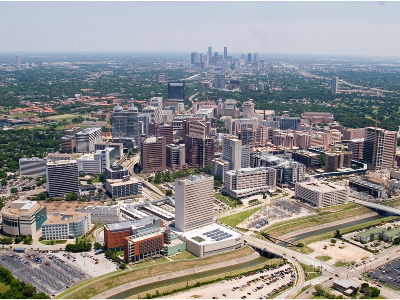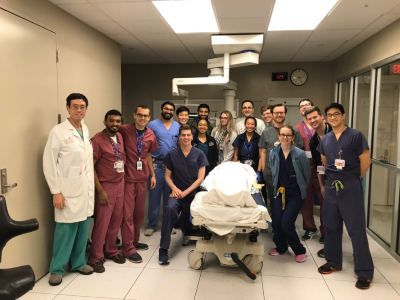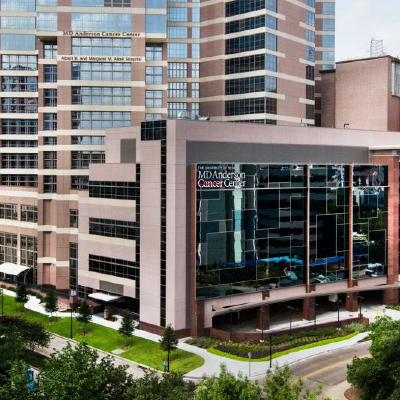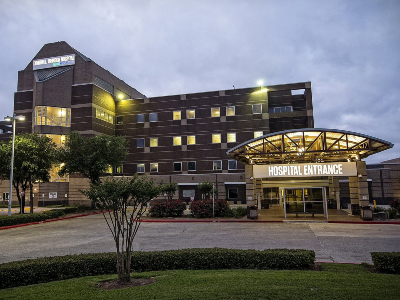Curriculum and Education

The Texas Medical Center
Curriculum
The diagnostic radiology program at UTHealth is uniquely positioned to provide exposure to a wide breadth of disease states, a critical component of radiology training.
Our training institutions complement one another and culminate into a comprehensive training experience which produces residents who are well-prepared for both academic and private practice sectors. Memorial Hermann Hospital- Texas Medical Center is a Level 1 trauma center with over 1,000 beds that provides leading-edge care in cardiology, neuroscience, orthopedics, and much more. Lyndon B. Johnson General Hospital is a Level 3 trauma center which provides comprehensive primary and specialty care to a large catchment area. MD Anderson Cancer Center is one of the preeminent cancer centers in the world. Our affiliation with Texas Children’s Hospital affords exposure to complex pediatric patients at a leading institution.
Years 1-3: Core Clinical Rotations
Residents are typically assigned in two- or four-week blocks to one of the following subspecialty areas of radiology (approximate total length of time):
- Breast imaging (8 weeks)
- Emergency radiology (8 weeks)
- Gastrointestinal / Genitourinary radiology (26 weeks)
- GI fluoroscopy (4 weeks)
- Interventional radiology (12 weeks)
- Musculoskeletal radiology (8 weeks)
- Neuroradiology (16 weeks)
- Night Float (18 weeks)
- Nuclear medicine (14 weeks)
- Pediatric radiology (12 weeks)
- Thoracic and Cardiothoracic radiology (12 weeks)
- Ultrasound (10 weeks)
Additional rotations include:
- American Institute for Radiologic Pathology (4 weeks)
- MD Anderson General, a blend of multiple subspecialities with an emphasis on oncology (4 weeks)
From the beginning of R1 (PGY-2) year, residents are expected to read independently, be involved in the performance and interpretation of patient examinations, and participate in discussions concerning diagnostic problems. The core principles of radiology are emphasized throughout each rotation. The residents are encouraged to work toward increasing levels of responsibility, particularly in the emergency radiology rotations and in the time leading up to call.
Generally, the subspecialty divisions are organized by body system, and each encompasses a variety of modalities, enabling residents to become familiar with anatomy, pathology and pathophysiology of disease spanning the entire body. Our radiologists and residents alike are valuable members of the patient care team.
Year 4: Elective Year
The Elective Year represents a valuable educational opportunity to pursue advanced exposure to many modalities and procedures.
Residents can take several elective rotations including Cardiac MRI, Body MRI, PET/CT, Musculoskeletal Imaging, Neuroradiology, as well as a Healthcare Management course and dedicated pathways, including ESIR, MDACC Research, and Nuclear Medicine.
ESIR Pathway
Early Specialization in Interventional Radiology (ESIR) is a training option for Diagnostic Radiology residents who wish to specialize in interventional radiology. ESIR training is completed within the 4-year diagnostic radiology residency. It requires a total of 11 IR or IR-related rotations (minimum of 44 weeks) and an ICU rotation of at least 4 continuous weeks. During the ESIR year, the resident must document at least 500 interventional radiology or IR-related procedures. Residents need to declare their interest in the ESIR pathway by the middle of the R3 year. Currently, we accept up to 4 R3 residents each year for this pathway.
Certificate in Healthcare Management
Interested residents may choose a month-long elective during their R4 year to obtain a Certificate in Healthcare Management through the University of Houston at Clear Lake, which is located in the Texas Medical Center. This elective certificate course features targeted lectures encompassing the fundamentals of management and leadership. Topics covered include hard skills such as professional finance and accounting, practice management, and marketing, as well as soft skills like negotiation, leadership, and organizational culture and change management.
Education
Teaching in each clinical section occurs at the workstation daily. Our faculty are subspecialty trained, maximizing the quality of image interpretation and procedural skills that our trainees develop throughout their residency.
Residents attend daily noon conferences given by radiology faculty across all subspecialties; this is a comprehensive lecture series spanning all areas of radiology. In addition, residents are taught non-interpretive skills including effective communication, ethics and professionalism, the business of medicine, research, wellbeing, quality and safety, and practice habits. Journal Clubs, M&M and QI conferences occur monthly.
In addition, residents attend pediatric conferences at Texas Children’s Hospital twice monthly, and there are various visiting professor lectures which occur on a regular basis. Our physics curriculum includes lectures, modules, hands-on labs, and board reviews taught by dedicated medical physicists. The R3 residents are provided extensive board review preparation prior to the American Board of Radiology (ABR) core exam.

Resident simulation session during Fundamentals
R1 Fundamentals Course:
This foundational course takes place every Wednesday afternoon during the entire R1 year, from July through June. The curriculum covers the basic principles of radiology and prepares residents for Night Float before beginning the R2 year. Residents obtain education in all radiologic subspecialties, as well as physics, radiation safety, contrast reaction simulation training, and hands-on IR and ultrasound experiences. In addition, there are dedicated boot camps in June of R1 year to ensure residents are well-prepared for call.



